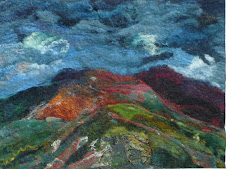I had wondered whether what I made with my concentrated dyes were inks or paints. The suggestion from various members of Natural Dyes Online was that it depended on whether you used brushes or a pen.
below is quote from a paper on Chinese Ink I found interesting.
" Typical artist's colorants are either dyes which form a true solution or may be precipitated onto an inorganic phase to form a lake, or large sized pigments mixed with a vehicle to create paint. In contrast the nano sized carbon primary components of Chinese Ink 10-150nm carbon soot particles, make it a colloidal dispersion or sol ( aqueous dispersion)" (Characterization of Chinese ink in size and surface Joseph R.Swider, Vincent A. Hackley. John Winter Journal of Cultural Heritage 4 (2003) 175-186)
I have really enjoyed the bit of reading about Chinese ink, which is basically soot mostly from wood soot usually pine wood soot,and glue but as the article pointed out the Chinese developed this type of ink into a very sophisticated form which being carbon based is not prone to fading and sticks well to the paper or in earlier times wood. Sometime after discovering wood soot lamp soot which made finer particles of carbon was found to make the very best inks. Apparently the soot and glue had to be pounded 5000 times and I immediately had a vision of some poor apprentice, arms aching, pounding away to make the ink. The glue -made from animal hide- is hugely important. Without it soot does not work as ink and the glue acts as a dispersing agent so the ink flows smoothly and as a binder to fix the ink. There was also some evidence that it stopped fungal growth too. The article did not describe how to make the ink and I shall have to look elsewhere for that but as the ink got more sophisticated more ingredients were added some to disguise the smell and some to improve colour such as indigo I was interested to read. One final point is that Chinese ink when mixed is a paste which is set in wooden moulds , so as time went on making these ink blocks became an art form. The ink block had to be rubbed on an ink stone to create the ink.
All this information will no doubt sound quite basic to anyone with any knowledge of inks but it is new to me so I found it quite fascinating and it has been a help summarising my reading if only very briefly.
On another note David Brightmore whose casual comment started me off on the journey into the world of inks came to see me and my studio today and left clutching my inks for a bit for experimenting . Now that could be really interesting!
December update
-
I updated my operating system in early December and bam, I was unable to
post any photos to my blog. All the suggestions made no sense, since there
were...
15 hours ago



























Interesting things about old inks!
ReplyDeleteHi Leena I am starting to read up about it all as the books recommended by Dorothy have now arrived.
ReplyDelete